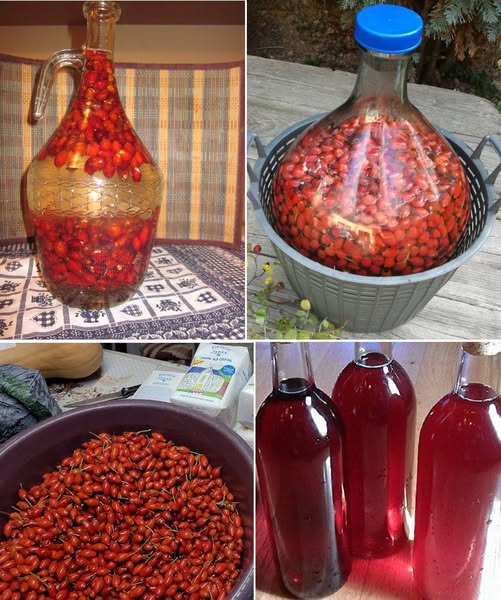Rosehip wine is a delicious, antioxidant-rich beverage that has been enjoyed for centuries. Not only does it offer a smooth, fruity flavor, but it’s also packed with vitamin C, flavonoids, and digestive benefits. Whether you’re a wine enthusiast or simply love experimenting with homemade beverages, this guide will take you through each step of making rosehip wine at home.
This traditional, natural wine takes some time to prepare, but the reward is a rich, aromatic drink that improves with age. Let’s dive into the process and uncover the secrets of crafting the perfect rosehip wine.

Why Make Rosehip Wine?
Rosehips—the bright red fruit of the wild rose plant—are loaded with nutrients, antioxidants, and medicinal properties. Drinking rosehip wine in moderation can provide:
✅ Immune system support – Rosehips contain high levels of vitamin C, which helps boost immunity and fight colds.
✅ Improved digestion – This natural wine can aid digestion and promote gut health.
✅ Heart health benefits – Rich in flavonoids, rosehip wine supports better circulation and cardiovascular function.
✅ A natural energy booster – Perfect for cold winter nights, this wine acts as a warming, revitalizing tonic.
Ingredients Needed
To make a high-quality, flavorful rosehip wine, you’ll need:
✔ 3 kg (6.6 lbs) fresh rosehips – Ideally picked after the first frost for a sweeter, richer flavor.
✔ 1 kg (2.2 lbs) sugar – Helps with fermentation and enhances sweetness.
✔ 100 g (3.5 oz) fresh brewer’s yeast – Essential for fermentation.
✔ 10 liters (2.6 gallons) of spring water – Ensures a pure and natural taste.
✔ Optional: 1 lemon – Adds a hint of acidity and balances the flavor.
✔ Optional: Spices like cinnamon or cloves – For a warm, aromatic touch.
Step-by-Step Guide to Making Rosehip Wine
Step 1: Preparing the Rosehips
🔸 Wash the fresh rosehips thoroughly to remove any dirt.
🔸 Lightly crush them using a wooden spoon or blender to release their natural juices and nutrients.
🔸 If you prefer a clearer wine, remove the seeds before fermentation.
🌿 Pro Tip: If you didn’t harvest after frost, freeze the rosehips for 24 hours before using them—this mimics the frost process and sweetens the fruit naturally.
Step 2: Making the Must (Fermentation Mixture)
🔸 Place the crushed rosehips into a large glass or ceramic container. Avoid metal, as it can affect fermentation.
🔸 Add the sugar, mixing well.
🔸 Dissolve the yeast in a small amount of warm water, then pour it into the container.
🔸 Gradually add 10 liters of spring water, stirring continuously.
🔸 Cover the container with a clean cheesecloth to allow air circulation while preventing contamination.
🔸 Leave it in a warm, dark place for 10-14 days.
🌿 Pro Tip: Stir the mixture once a day using a wooden spoon to ensure even fermentation.
Step 3: The Fermentation Process
🔸 Over the next two weeks, the mixture will start to ferment. You’ll notice bubbles forming and a mild, sour aroma—this means fermentation is working!
🔸 After 14 days, strain the liquid using a fine mesh or cheesecloth to remove solids.
🌿 Pro Tip: For a richer wine, let the mixture ferment for 3 weeks instead of 2 before straining.
Step 4: Maturing the Wine
🔸 Transfer the strained liquid into a glass demijohn or fermentation barrel.
🔸 Cover it with an airlock (or use a hose placed in a jar of water to allow gases to escape).
🔸 Let the wine mature in a cool, dark place for 6-8 weeks.
🌿 Pro Tip: The longer you let it sit, the smoother and richer the flavor will be!
Step 5: Bottling and Storing
🔸 Once the wine has fully matured, strain it one final time.
🔸 Pour the filtered wine into sterilized glass bottles.
🔸 Store the bottles in a cellar or pantry at 10-15°C (50-59°F).
🔸 Let it age for at least a few months—the longer, the better!
🌿 Pro Tip: If you want a slightly sparkling effect, add a small amount of honey before bottling.
Tips for the Best Homemade Rosehip Wine
✔ Use ripe, frost-touched rosehips – The natural sugars increase after frost, leading to better flavor.
✔ Avoid metal containers – Fermentation can react with metal, altering the taste. Stick to glass or ceramic.
✔ Try adding honey instead of sugar – This gives the wine a softer, richer sweetness.
✔ Experiment with spices – Adding cinnamon, cloves, or vanilla during fermentation gives the wine a warm, aromatic depth.
✔ Be patient – The longer you let the wine age, the smoother and more flavorful it will become!
Conclusion: Enjoying Your Homemade Rosehip Wine
Rosehip wine is a truly unique and rewarding homemade beverage. With its rich flavor, natural health benefits, and smooth finish, it’s a perfect drink to enjoy on a cozy evening or share with friends and family.
By following this step-by-step guide, you can create your own natural, high-quality wine that’s free of additives and preservatives. Whether you sip it warm in winter or chilled in summer, rosehip wine is a true delight for wine lovers and homebrewers alike.
Have You Tried Making Rosehip Wine?
We’d love to hear about your experience! Drop a comment below or share your favorite homemade wine tips.
🍷 Inspired by this? Share this article with your friends! 🌿✨





